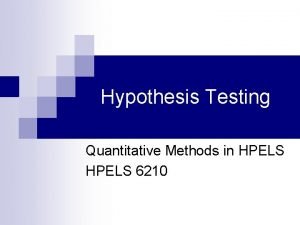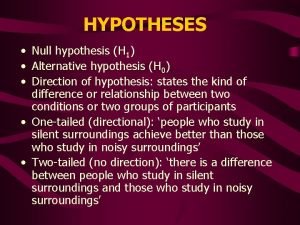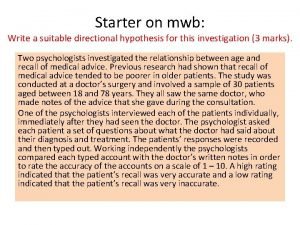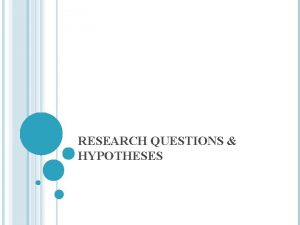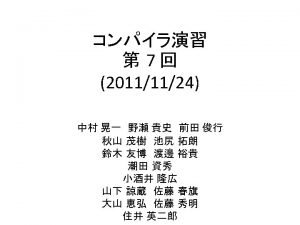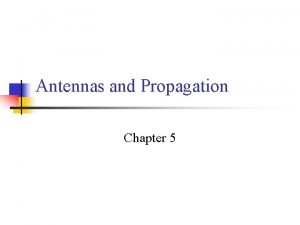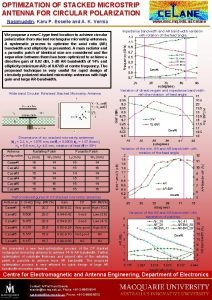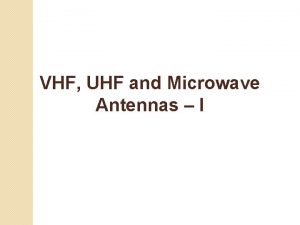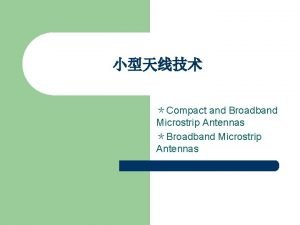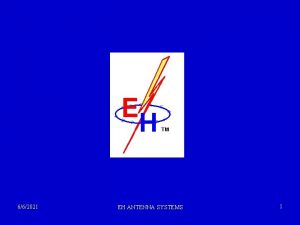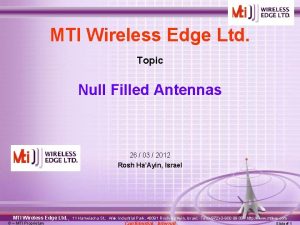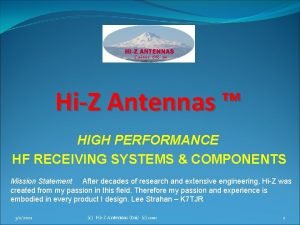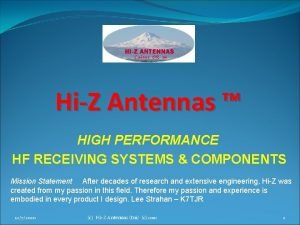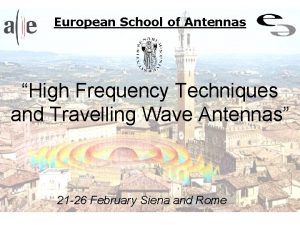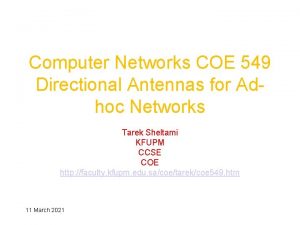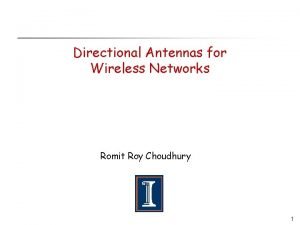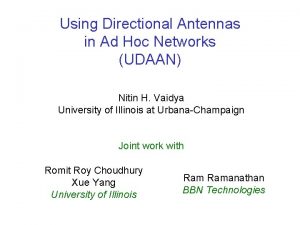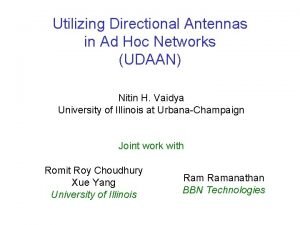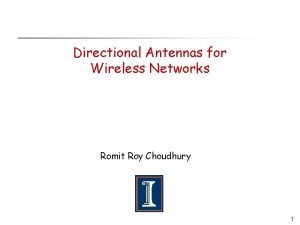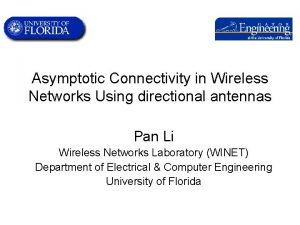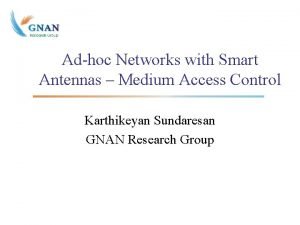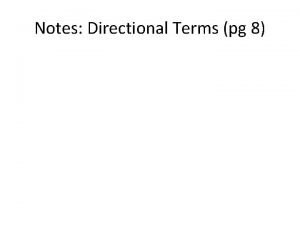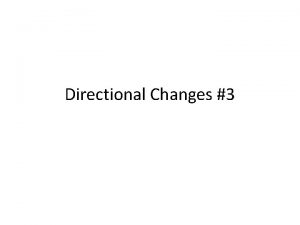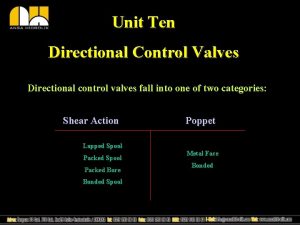Directional Antennas for AdHoc Networks Andy Collins UW


















- Slides: 18

Directional Antennas for Ad-Hoc Networks Andy Collins UW CSE 802. 11 Seminar 23 July 2003

Problem and opportunity • Ad-hoc networks are limited in capacity – More power = fewer hops but more interference • Technology will (soon) allow steerable antennas – Using phased arrays • High gain (10 X to 1000 X) • Electronically steerable (no physical rotation) • Less interference to nodes in other directions • Can we break the capacity bounds? – More gain ? = fewer hops and less interference

Major challenges • Neighbor discovery – Goal is to use hops that require directional antennas at one or both ends • How does sender know where to aim • How does receiver know to aim (and where)? • Hidden transmitters – Cannot hear nearby nodes pointing away • More interesting than geography because it changes fast • Must rethink MAC protocol

Antenna basics • Antennas are governed by two properties: – Efficiency: fraction of input power not lost as heat – Gain: concentration of energy in one direction • We focus only on gain – Can only reshape energy • The sum of power over the sphere must stay constant • Implies a direct tradeoff between gain and beamwidth • Some energy always ends up in “sidelobes” off the main beam

Antenna terminology • Gain is typically measured in decibels (d. B) – True d. B is a unitless ratio describing gain or loss through a component • Also used for amplifiers and attenuators, and path loss – Logarithmic: d. B = 10 log 10 (power out/power in) • 3 d. B is approx. twice as much power, 10 d. B exactly 10 X – Antenna gain is figured relative to isotropic (d. Bi) • An ideal omnidirectional radiator • This is the gain in the center of the beam

A gain antenna

Phased arrays • A phased array is a group of individual antennas grouped and fed together – Usually each element is omnidirectional – Pattern is determined by geometry and phase delay – Magic is in varying phase delay to each element to steer the beam without moving the elements – Long history of military use for radar – Can also use as omni receiver, and sense arrival direction • Very different from other sorts of directional antennas you’ve probably seen – Yagis, Log-periodic arrays, parabolic dishes

Modeling gain antennas • Both papers use a simplified model – Beam is uniform gain within its beamwidth – Single, uniform sidelobe • Can calculate gains and beamwidth – Max width a function of gain – Sidelobe gain a function of gain and selected beamwidth

Meanwhile, back in computer science… • Step 1: directional antennas for interference only – Use omni antennas for routing and MAC • Step 2: directional transmit / omni receive – Use geometry information to know where to send – Will use the term “DO” for “directional omni” • Step 3: double directional – Create a protocol to arrange for the receiver to aim back at the sender – Termed “DD” for “directional”

Interference reduction • What happens if we use normal omni MAC and directional data transmission? – Implies no improvement in hop count • Except for some ideas on power or processing tradeoffs – Can dramatically reduce the likelihood of collision • Especially if we also reduce power • Data transmission is most of the time spent • Must relax MAC rules to get this benefit • Ramanathan shows useful benefit

Ramanathan results Setup: 40 nodes, steered beams, “aggressive” CA, power control

Basic DMAC algorithm • A MAC algorithm for “DO” operation – Must know where receiver is to point beam – Can only get “half” the gain benefit • Although they also propose using receiver gain for data • Basically like 802. 11, but per-direction – Sender aims at receiver and sends RTS • As always, after doing aimed carrier sense – Non-receivers update DNAV for arrival direction – Receiver sends aimed CTS

DNAV table operation

Basic DMAC problems • Hidden terminals – “Asymmetry in gain”: can only hear RTS/CTS within “DO” range, but can interfere out to “DD” – Can’t hear nearby RTS/CTS when focused away – Can’t hear nearby transmissions in same direction • Deafness – Can’t tell when receiver is focused away and doesn’t hear RTS

Multi-hop RTS MAC algorithm • Can we use “DO” routing to set up “DD” hops? – Assume network is dense enough, and we have map

MMAC algorithm continued • Basically the same steps, but each repeated for “DO” and “DD” – Sender first aims a “DD” RTS towards receiver • Probably won’t be heard at receiver, unless it happens to be aimed properly for some reason • Point is to alert others along the path (who update DNAV for both arrival direction and opposite (where the receiver is) – Sender sends a “DO” RTS along the “DO” route to receiver • This is forwarded, but must be dropped rather than delayed in any queues – Receiver aims a “DD” CTS towards sender • This will be heard, because sender is expecting it • Also alerts intermediates near the receiver

MMAC problems • Hidden terminals – MMAC inherits all the DMAC hidden terminals • Directly, since it also does “DO” communication • Plus some “DD” analogs – “DD” signal may not reach all in-between nodes • It is not the case that all nodes between a pair of “DD” nodes can hear even one endpoint using “DO” reception – If gain > 6 d. Bi, then adding receiver directivity increases range by more than a factor of two – Nodes directly between “DD” pairs may not hear either end • But any node between a pair can interfere if it beamforms – And carrier sense will only work if it points towards the sender

Applicability of beamforming • What kinds of networks are a good match? – Nodes must know location and orientation • Although some algorithms may work purely by sensing incoming direction, and building only a logical map – Antenna arrays are larger than simple antennas • Typical setup is a circle of elements and 1/2 l spacing – Or about 16 cm diameter for 2. 4 GHz – But much smaller for X band above • Higher gain does require larger arrays – As well as more stable platforms • Fixed systems make a lot of sense – Vehicular too, if we can fold in mobility
 Directional and non directional hypothesis
Directional and non directional hypothesis Directional hypothesis example
Directional hypothesis example Directional and non directional hypothesis
Directional and non directional hypothesis Directional and non directional hypothesis
Directional and non directional hypothesis Example directional hypothesis
Example directional hypothesis Directional and non directional hypothesis
Directional and non directional hypothesis Example of statement of the problem in research
Example of statement of the problem in research Ad hoc polymorphism c++
Ad hoc polymorphism c++ Adhoc.com
Adhoc.com Antennas and propagation
Antennas and propagation Nasimuddin+microstrip+antennas
Nasimuddin+microstrip+antennas Vhf uhf and microwave antennas
Vhf uhf and microwave antennas Broadband microstrip antennas
Broadband microstrip antennas Eh antenna theory
Eh antenna theory (“mti wireless edge” or mtiwe) and anten
(“mti wireless edge” or mtiwe) and anten Hi z antennas
Hi z antennas Hi-q antennas
Hi-q antennas Hi-z antennas
Hi-z antennas European school of antennas
European school of antennas
